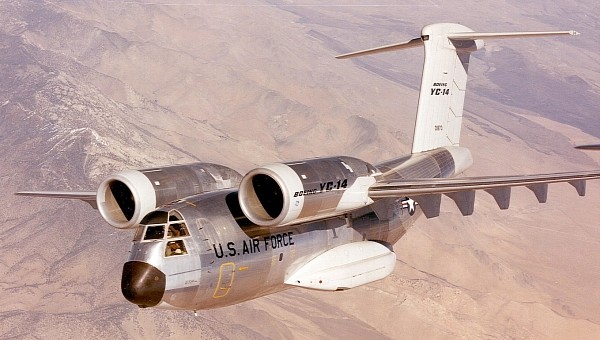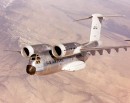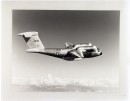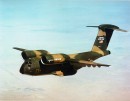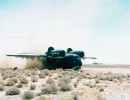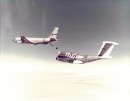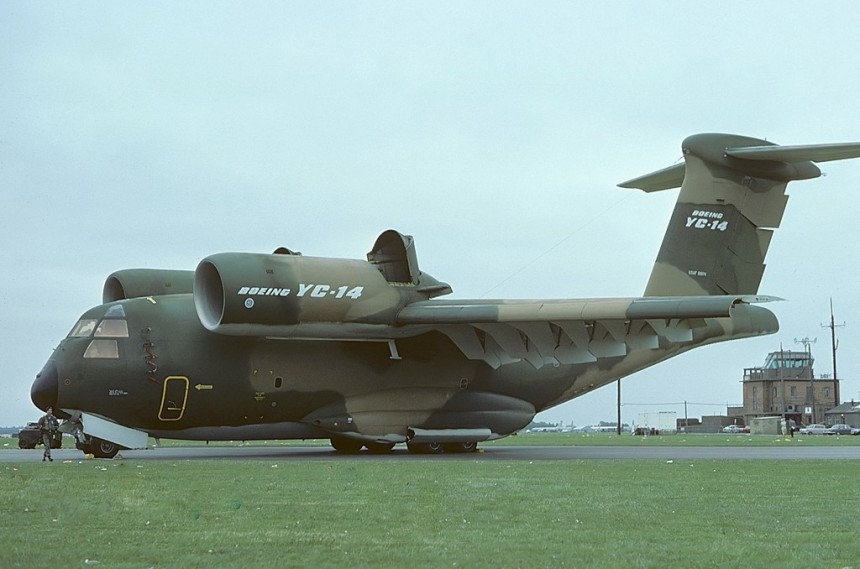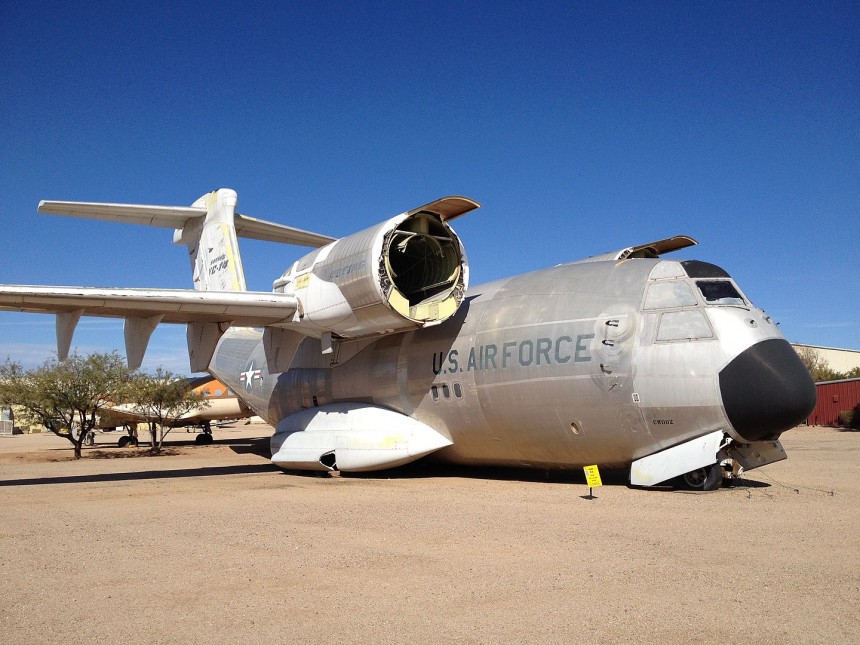Back in the '70s, Boeing could do no wrong, it seemed. That's especially poignant knowing what a mess of things they'd make later in the 2010s. But even in the earliest days of the 747, a military project was underway at Boeing that failed by all conventional measurements.
But that's only half of the story. This is the tale of the YC-14, a quirky twin-engine short takeoff and landing (STOL) cargo jet that almost nobody remembers.
On first impressions alone, the Boeing YC-14 is a visually stunning airplane. It's as if somebody took Lockheed's C-130, played around with the aspect ratio, and swapped out its four turboprop engines for two turbofans mounted tightly against the fuselage above each wing root. Believe it or not, the YC-14's genesis is founded in a U.S. Military program meant to supplement and one day replace its vast fleet of C-130 Hercules cargo planes.
Calls for an airplane roughly the size of the C-130 and powered by turbofan engines were answered by both Boeing and McDonnell Douglas. Of course, Boeing would one day acquire their rival company (August 1997). At the heart of Boeing's strategy for their new cargo plane was the development of a novel, externally blown wing flap system. Using high-pressure air directed to the rear edge of a jet's wing, the natural vortexes created as wings cut through the air can be artificially altered, generating more lift than a wing can on its own in the process.
Certain variants of jets like the Lockheed F-104 Starfighter and the Mikoyan-Gurevich MiG-21 also played around with similar flap mechanisms. Because the MiG and the Starfighter were like bricks with wings and not very maneuverable, they'd surely benefit from the better low-speed performance this kind of technology provides. Boeing first devised the device for a competitor project to compete against the Lockheed C-5 Galaxy.
Though Boeing lost this competition, the 747 civilian airliner surely compensated plenty for this military defeat. In the YC-14, jet flaps were a key feature in making its takeoff distance as small as possible. The plane's trademark engine nacelles are mounted nearly flush against the fuselage and the wing. All in the name of manipulating weight distribution in favor of shorter, faster takeoffs from possibly unprepared runways, as the C-130 was known for.
When this considerable lev tech is used in combination, the YC-14 utilized a fascinating quirk of aeronautical mechanics called the Coanda effect to a stunning degree. Using this, the YC-14's flaps helped the plane seemingly defy the laws of physics. Even when in a near vertical climb and banked in a 20-degree turn, the YC-14 could still maintain a rate of climb of over 6,000 feet (1,828 meters) per minute. Even today, that's impressive for a cargo plane.
The U.S. was desperate for a jet of the YC-14's caliber. A cargo jet that can haul 170,000 lbs (77,270 kg) of its own airframe, plus supplies, troops, weapons, and vehicles from seemingly impossibly short takeoff distances, already had considerable potential before the Iran hostage crisis of 1979. But using the combination of all this technology, Boeing built a plane years ahead of its time to make it happen.
The YC-14 made its maiden flight on August 9th, 1976, with the second prototype joining the first in testing service a short time later. But unparalleled STOL hauling wasn't the only thing being tested inside the YC-14. Inside the cockpit was the predecessor to all modern digital flight displays. Each display used cathode ray tube monitors similar to the color TVs Janice Joplin used to sing about.
Because of this, each YC-14 crew bathed in the warm glow that only old-fashioned TVs could replicate. The center display was flanked on all sides by old-fashioned dials and gauges. Such an eclectic blend of old-school and computer-aged flight instruments made for a cockpit unlike almost anything else ever built. An aesthetic only a handful of planes from the late 60s through the early 90s can lay claim to.
By this stage in development, the TAI program, which birthed the YC-14 and its competitor, the McDonnell Douglas YC-15, had evolved into the Advanced Medium STOL Transport (AMST) competition. In application, the YC-15 was far different than its rival from Boeing. With its quad turbofan engines mounted in a more traditional under-the-wing configuration, the two approaches to STOL couldn't have been more different.
Stemming from the extra engines, the YC-15 sported a higher cruising speed while carrying a few tons more cargo than the YC-14. But these same engines also ensure the YC-15's range of 2,995 mi (4,800 km) with a payload that couldn't match the YC-14's 3,190 mi (5,136 km). Completion of flight testing on both aircraft concluded in 1977. At this point, both YC-14s made to that point were sent back to Boeing.
Meaning, of course, the capabilities of two of the most advanced STOL cargo jets ever built wound up not being used even remotely close to their potential. Except, that's not entirely true. After the end of the program, the best quirks and traits of both jets involved were combined into what is today the C-17 Globemaster III. Knowing the story of both AMST aircraft, it's hard not to see design cues from either jet applied to the Globemaster III in every nook and cranny of its construction.
Known the world over for impressive takeoff distances for such a massive quad-engine cargo jet, you can't help but think the YC-14's after-effects had a far more profound effect on military aviation space. But suppose you're longing for freaky-looking jets with over-wing engines. Well, legend has it some Ukrainian communists were snooping around the immediate vicinity of the AMST program's flight testing. Whether this was through sneaky espionage or just snooping in via satellite is unclear.
The Ukrainian aerospace firm Antonov has never stated openly if the American AMST program had any bearing on their An-72 STOL transport. Even almost 50 years later, neither Boeing, the Pentagon or any Iron Curtain-affiliated third party have commented on the matter. But come on, look at the thing! Apart from the snub-nose of the YC-14, there's very little between the two jets from a stylistic perspective. Interestingly enough, the Antonov flew its first An-72 out of an airfield in Kyiv almost exactly a year to the date of the YC-14's first flight.
We certainly can't claim it to be a certainty, but something about the timing of all of this seems very "sus" indeed. Almost 200 Antonov An-72s have been built since 1977. Meanwhile, the two YC-14s manufactured by Boeing's facility in Renton, Wahington, made their way to USAF bone yards. The first example built, serial number 72-1873, is currently sitting outside the Pima Air & Space Museum near Tucson, Arizona. The other is in long-term mothball storage at the AMARG boneyard at Davis Monthan Air Force Base southeast of Tuscon.
If nothing else, this only proves the only warbird capable of directly replacing the C-130 Hercules is a better C-130 Hercules. Sometimes it takes a big investment to figure these things out.
Check back soon for more vintage military plane profiles here on autoevolution.
On first impressions alone, the Boeing YC-14 is a visually stunning airplane. It's as if somebody took Lockheed's C-130, played around with the aspect ratio, and swapped out its four turboprop engines for two turbofans mounted tightly against the fuselage above each wing root. Believe it or not, the YC-14's genesis is founded in a U.S. Military program meant to supplement and one day replace its vast fleet of C-130 Hercules cargo planes.
A C-130 Replacement? We Don't Think So
Yeah, safe to say that didn't happen. But even so, the YC-14 is still a fascinating jet in its own right. Boeing first devised blueprints for a novel medium-sized cargo plane in response to a USAF paper study called the Tactical Aircraft Investigation (TAI). What the Air Force demanded from this new initiative was simple in theory. But then again, when are things ever simple in aerospace?Calls for an airplane roughly the size of the C-130 and powered by turbofan engines were answered by both Boeing and McDonnell Douglas. Of course, Boeing would one day acquire their rival company (August 1997). At the heart of Boeing's strategy for their new cargo plane was the development of a novel, externally blown wing flap system. Using high-pressure air directed to the rear edge of a jet's wing, the natural vortexes created as wings cut through the air can be artificially altered, generating more lift than a wing can on its own in the process.
Certain variants of jets like the Lockheed F-104 Starfighter and the Mikoyan-Gurevich MiG-21 also played around with similar flap mechanisms. Because the MiG and the Starfighter were like bricks with wings and not very maneuverable, they'd surely benefit from the better low-speed performance this kind of technology provides. Boeing first devised the device for a competitor project to compete against the Lockheed C-5 Galaxy.
Solving Problems With "More Powa Baby!"
Sporting twin General Electric turbofan engines with 51,000 lbs (230 kN) of thrust per unit, the YC-14 had plenty of power to take off like a dragster. A projected cruising speed of 449 mph (723 km/h) was significantly faster than its C-130 counterpart. But only when you watch footage of a YC-14 making an 800-foot (244 meters) takeoff run look like a cakewalk does it all start to make sense.When this considerable lev tech is used in combination, the YC-14 utilized a fascinating quirk of aeronautical mechanics called the Coanda effect to a stunning degree. Using this, the YC-14's flaps helped the plane seemingly defy the laws of physics. Even when in a near vertical climb and banked in a 20-degree turn, the YC-14 could still maintain a rate of climb of over 6,000 feet (1,828 meters) per minute. Even today, that's impressive for a cargo plane.
The U.S. was desperate for a jet of the YC-14's caliber. A cargo jet that can haul 170,000 lbs (77,270 kg) of its own airframe, plus supplies, troops, weapons, and vehicles from seemingly impossibly short takeoff distances, already had considerable potential before the Iran hostage crisis of 1979. But using the combination of all this technology, Boeing built a plane years ahead of its time to make it happen.
Because of this, each YC-14 crew bathed in the warm glow that only old-fashioned TVs could replicate. The center display was flanked on all sides by old-fashioned dials and gauges. Such an eclectic blend of old-school and computer-aged flight instruments made for a cockpit unlike almost anything else ever built. An aesthetic only a handful of planes from the late 60s through the early 90s can lay claim to.
By this stage in development, the TAI program, which birthed the YC-14 and its competitor, the McDonnell Douglas YC-15, had evolved into the Advanced Medium STOL Transport (AMST) competition. In application, the YC-15 was far different than its rival from Boeing. With its quad turbofan engines mounted in a more traditional under-the-wing configuration, the two approaches to STOL couldn't have been more different.
Stemming from the extra engines, the YC-15 sported a higher cruising speed while carrying a few tons more cargo than the YC-14. But these same engines also ensure the YC-15's range of 2,995 mi (4,800 km) with a payload that couldn't match the YC-14's 3,190 mi (5,136 km). Completion of flight testing on both aircraft concluded in 1977. At this point, both YC-14s made to that point were sent back to Boeing.
A Capable Jet Well Ahead of Its Time
In the end, both McDonnell Douglas and Boeing exceeded expectations with their designs. But it wasn't anything at all to do with the planes themselves that doomed the AMST program. Instead, the minutiae about whether the U.S. military wanted to use their cargo planes in a tactical or a strategic manner wound up becoming an impassable stalemate which brought about the complete closure of the entire program.Meaning, of course, the capabilities of two of the most advanced STOL cargo jets ever built wound up not being used even remotely close to their potential. Except, that's not entirely true. After the end of the program, the best quirks and traits of both jets involved were combined into what is today the C-17 Globemaster III. Knowing the story of both AMST aircraft, it's hard not to see design cues from either jet applied to the Globemaster III in every nook and cranny of its construction.
Known the world over for impressive takeoff distances for such a massive quad-engine cargo jet, you can't help but think the YC-14's after-effects had a far more profound effect on military aviation space. But suppose you're longing for freaky-looking jets with over-wing engines. Well, legend has it some Ukrainian communists were snooping around the immediate vicinity of the AMST program's flight testing. Whether this was through sneaky espionage or just snooping in via satellite is unclear.
The Ukrainian aerospace firm Antonov has never stated openly if the American AMST program had any bearing on their An-72 STOL transport. Even almost 50 years later, neither Boeing, the Pentagon or any Iron Curtain-affiliated third party have commented on the matter. But come on, look at the thing! Apart from the snub-nose of the YC-14, there's very little between the two jets from a stylistic perspective. Interestingly enough, the Antonov flew its first An-72 out of an airfield in Kyiv almost exactly a year to the date of the YC-14's first flight.
If nothing else, this only proves the only warbird capable of directly replacing the C-130 Hercules is a better C-130 Hercules. Sometimes it takes a big investment to figure these things out.
Check back soon for more vintage military plane profiles here on autoevolution.
